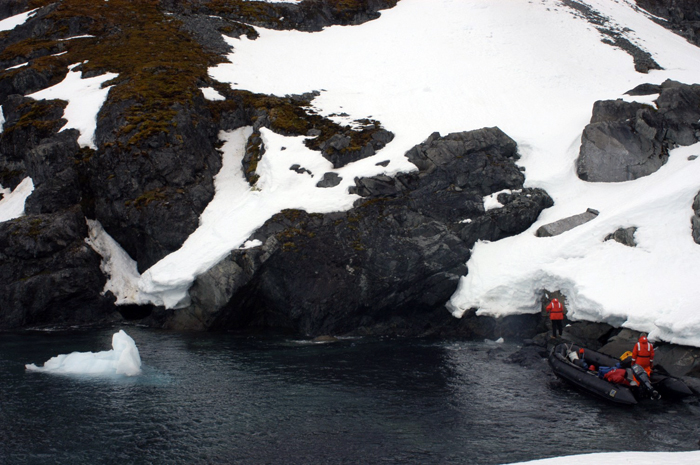|
Different methodsBarbeau and Dalziel share a similar goal of dating the opening of the Drake to help settle the matter, but the separately funded National Science Foundation More Information
Barbeau, an assistant professor at the University of South Carolina, led an island-hopping science cruise aboard the ARSV Laurence M. Gould in November and December of last year to the Antarctic Peninsula to collect samples from rock outcrops. He and his team then spent another month in January traveling around Argentine Tierra Del Fuego, chipping off similar fist-sized chunks of rock for analysis. Once upon a time, before the Drake Passage formed, a range of mountains, the Andes, connected Antarctica and South America. Barbeau believes that by matching and dating rock samples on both sides of the Drake, he can better determine when the two sides parted ways, which would help date the opening of the passageway. “They have very similar geology on both sides and they fit together fairly nicely as a puzzle, like South America and Africa fit together nicely for that Pangaean reconstruction that people talk about,” Barbeau said, referring to the supercontinent of Pangaea that existed about 250 million years ago before the continents began to separate into their present-day form. “When South America and Antarctica stopped having the same sort of sediments being deposited on them would be a separate indicator of when Antarctica was separated from South America, and therefore when the Drake Passage could open and the ACC could develop,” he explained. A senior research scientist with the Institute for Geophysics at the University of Texas in Austin, Dalziel led a science cruise aboard the RVIB Nathaniel B. Palmer from mid-April through the end of May. The vessel plied the central Scotia Sea, located partly in the Southern and Atlantic oceans, to refine the age of the seafloor in an area that had presented puzzling anomalies in the past. The survey involved using geophysical instruments, such as a seismic reflection system that uses sound to image the seafloor, and dredging for volcanic basalt. “The low-tech way to do it is to hang a bucket behind the ship and see if we can collect some rocks,” Dalziel quipped. It may be low-tech, but finding the right rocks isn’t easy. The seafloor, Dalziel explained, is littered with drop stones — material transported by icebergs as they drift north and drop rocks trapped in the ice to the seafloor as they melt. “A lot of time what you’re picking up are rocks that have come from some unknown place,” he said. “They don’t help at all; they just get in the way.” Still, the dredging program was successful. “We got a lot of drop stones, but we did manage to get a lot of material that we are confident is from the oceanic basement underneath the sediments,” he said. Geochemical analyses of the samples will take the better part of a year, Dalziel added, because colleagues must separate individual mineral grains from the big chunks of rocks. Meanwhile, Dalziel and his team will study the geophysical data. Different discoveriesBoth projects are part of an International Polar Year-affiliated program called Plates and Gates And both scientists — Barbeau on his first trip to the Antarctic and Dalziel a 35-year veteran of polar science — say they made some provocative discoveries during their expeditions. In 2005, Barbeau conducted an exploratory project in the southern Argentine Andes. Data from sedimentary samples in a basin near the mountains showed significant changes in the southern Andes’ composition about 30 to 45 million years ago. That means something tectonically big was under way. The samples he and his team collected in the same region in January confirm the results from three years ago, and appear to narrow the event to about 35 to 40 million years ago. “What’s more exciting is that it fits in perfectly with the timeline we’re talking about.” The Antarctic Peninsula rocks, however, don’t show evidence of this tectonic event. But Barbeau is not discouraged. “It suggests that the tectonic activity that led to the opening of the Drake Passage was focused more on the South American side than the Antarctica side,” he said. “It’s not a deal breaker.” For Dalziel, the Palmer cruise created even more questions, because the Scotia Sea where his team sampled turns out not to be straightforward lithosphere, or ocean crust. “It’s distinctly different,” he said. “It turns out that the central Scotia Sea is very different in its character. It does not consist of normal mid-ocean ridge basalt.” He said it will require a lot of time “under the microscope” and geochemical analyses for age dating to determine exactly what the scientists have discovered. The revelation further complicates the study of the Drake Passage theory. “It’s not going to make it easy to understand exactly when a deep ocean passageway formed,” Dalziel said. |



For USAP Participants |
For The Public |
For Researchers and EducatorsContact UsU.S. National Science FoundationOffice of Polar Programs Geosciences Directorate 2415 Eisenhower Avenue, Suite W7100 Alexandria, VA 22314 Sign up for the NSF Office of Polar Programs newsletter and events. Feedback Form |



